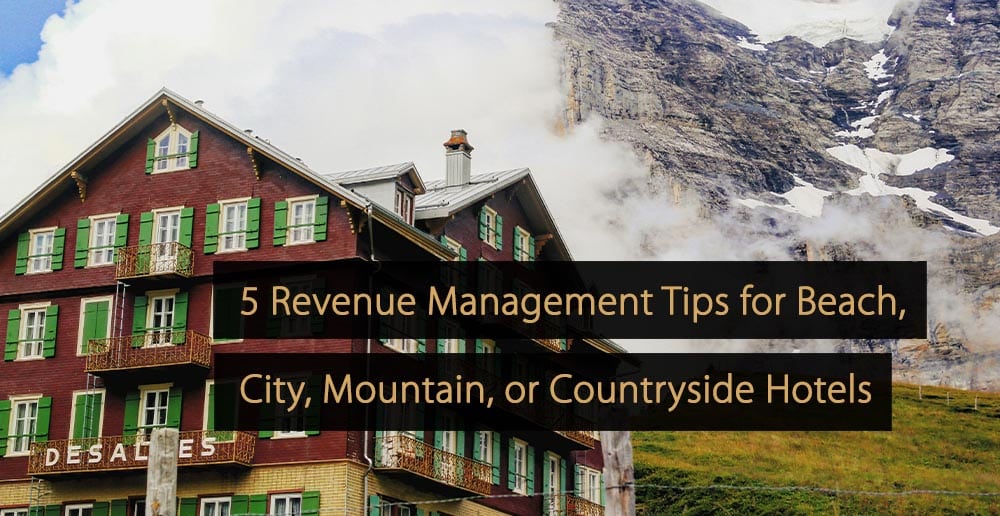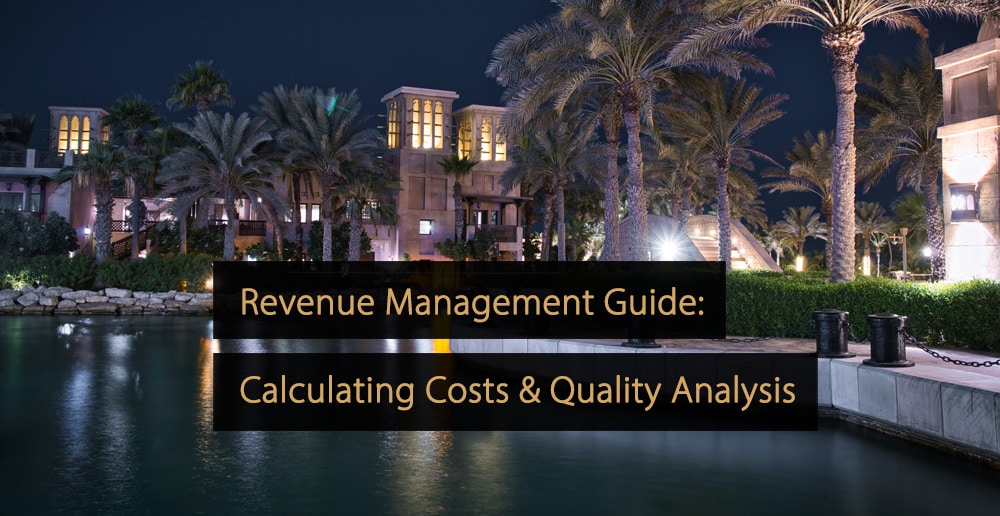As a hotelier, you know your hotel faces unique revenue management challenges. Your location, primary types of travelers, and the season of the year all play into profitable pricing strategies. This article addresses specific ways to improve your revenue and profitability, regardless of location or seasonality.
Revenue Management Tips for Beach, City, Mountain, or Countryside Hotels
Some of these tips are essential to savvy revenue management practices regardless of location or seasonality. For instance, the importance of online visibility is universal. Without it, your guests won’t find you, and you’ll struggle with low bookings.
Others focus on the specific concerns of beach, city, mountain, or countryside hotels. For example, a seasonal hotel can implement a specific revenue strategy targeting family rooms that can more than triple your room rates during peak demand.
1. City Hotels
Your independent hotel is well-situated for business and leisure travelers and conveniently located to shops, restaurants, and city sights within walking distance and accessible public transportation.
However, because there are such differences between business and leisure travelers, you can treat your mid-week room rates and weekend rates like two different seasons. Take corporate rates. They can be a financial loss if you’re not careful.
Then, Sunday is traditionally a weak day in the city hotel landscape, but you could provide incentives for your guests that improve your bottom line in the short and long term.
Let’s consider corporate rates.
Corporate Rates
Should you negotiate corporate rates at static rates or a dynamic pricing approach? Dynamic pricing is a significant part of revenue management yet, you don’t have to choose one or the other. You can offer a website-only discount to specific companies with a personalized promo code. Such a code incentivizes corporations while you also compete in dynamic pricing on the OTAs.
Have a company that insists on a static rate? Consider whether it’s a good rate for your hotel during the time they want the rooms and don’t offer guaranteed allotments. There’s no point in booking several rooms at a low rate during high season when you would have sold the rooms to the public at higher rates.
If you have existing contracts, it’s worth reviewing them. Are the terms favorable to you? Review your OTA numbers and see if you often reduce your last-minute, mid-week rates. If so, that’s a sign to renegotiate your corporate contracts.
Rate Adjustments
The data shows most business people book close to their check-in date. They’re likely comparing rates on the OTAs. You can review your RMS statistics to understand your market segments better. If you need to drive more occupancy from OTAs and your website, it’s best to lower your rates weeks in advance rather than 2-3 days before the check-in date. You don’t want customer complaints about higher rates than what they see advertised on Booking.com or another OTA.
You can protect corporate agreements in two ways.
1-Raise prices on OTAs close to check-in. This protects your corporate contracts while still appealing to customers. Re-negotiate your contracts as soon as you can.
2- Add a clause in your contract guaranteeing corporate clients the best rate if they see a lower one online. That way, they know they’re getting the best deal possible.
Find out more in the ebook about ways to create brand loyalty from your business customers, why it makes sense to treat mid-week and the weekend as two different seasons, and how to turn Sunday into a profitable day of the week.
2. Beach Hotels
It’s probably not surprising that our data shows beach-side hotels that open earlier and stay open longer make more money. But the reasons why may surprise you.
It’s not simply a matter of adding a few more months to the open season. It’s also about putting smart revenue management practices in place.
Early reviews boost visibility
For example, if your hotel opens in April instead of June, you can launch the busy summer season with early reviews. Getting positive reviews in April and continuing them through the summer means your hotel will be front and center on the OTAs when the high season hits in July. Increased visibility with positive reviews means more bookings. You can incentive your guests to leave reviews by offering great service and asking for the review.
Review Your Cancellation Policy
In high season, you don’t want last-minute cancellations, which could potentially leave you with a gap in your bookings. Yet guests want flexibility, so how do you satisfy both parties? You could require a longer cancellation period during high season, such as if it’s less than 14 days, the guest is charged 100% of the stay as a penalty for late cancellation.
This gives your guests flexibility up to two weeks before their visit, so if they do cancel, you can apply progressive pricing adjustments to fill the space without offering last-minute discounts.
Then, during lower or shoulder season, you can adjust your cancellation with a two-day window (they pay the 1st night as a penalty.) This helps you maintain visibility on the OTAs.
Remember, as soon as a customer books, you have the chance to start building that relationship. Ask them the reason for their travel and make relevant suggestions for fun things to do in the area. When people feel appreciated, they’re less likely to cancel.
Optimize Your Family Room Rates
While some hotels price family rooms at an incremental increase to accommodate more people, that’s not the most profitable way.
Rather than taking the double room rate, adding $30 to it, and calling it a triple, you can implement revenue management to boost that room value by hundreds of dollars. You may be able to offer additional services for these families, such as discounts on nearby attractions. This can increase the perceived room value.
Savvy revenue management-minded hotels treat family rooms like other hotels with a separate pricing strategy.
We’ve seen specific peak dates with a starting difference of $60 between double and quadruple rooms jump to a final point of $600 because you move the price point independently on each based on demand.
3. Mountain Hotels
Once the domain of ski holidays and sipping hot chocolate by a roaring fireplace, mountain hotels see an influx of summer visitors looking to cool off from rising temperatures.
With a strategic pricing strategy, you can raise the hotel’s online visibility and maximize your peak season room rates.
Build Your Brand Reputation
Online ratings matter. Hotels with a 9 or more on Booking or a 4.5 or more on TripAdvisor, paired with effective revenue management, boost room rates three or even five times more than expected.
Our consulting firm has seen 3-star hotels with a 9+ score selling at more than $1.000 per night during peak wintertime events (such as NYE), while similar hotels with a lower score and no revenue management in place did not manage to cross $200.
Our statistics show if you provide excellence and quality, you can sell rooms at peak rates during peak events, and 8 out of 10 guests will leave positive reviews.
You can also re-visit your non-refundable deposits to increase your online visibility.
Review Non-Refundable Rates
Our data shows that applying weather-dependent non-refundable rates can limit online visibility and, therefore, the possibility of selling at higher rates. That’s because most people click the “Free Cancellation” filter on OTAs to narrow their hotel search. You’re missing out on this visibility if you only have a nonrefundable rate.
We recommend a variable cancellation policy depending on the season but skip the non-refundable rates and advance deposits. You can track your data to see the statistics on the booking window and cancellation rate on RMS and OTAs. Pair that with a study of historical performance (occupancy and ADR) to gain insight into your hotel’s best cancellation policy for the winter season.
4. Countryside Hotels
Each season is an opportunity to review rates. When you review historical data, you have guidelines for this season’s pricing.
Starting Rates
Track your market segmentation with a good RMS. That will show if you have groups, events, and weddings on a particular date. It’ll also track the historical pickups and Average Daily Rate (ADR) by room type (double rooms, family, suites, etc.) Other pricing factors include historical weather trends and the distance from other attractions. For example, is your hotel near a beach or a historic city? All of these affect your room rates and allow you to maximize revenues.
This information allows you to create effective pricing and map inventory to peak dates.
Prices and Inventory on Peak Dates
When demand is high, it makes sense to raise room rates. On such occasions, the guest pays for the destination and location rather than the room. For example, take a countryside hotel within an easy drive to a nearby beach or city destination with special events.
If the closer hotels are full, people will expand their search radius to other hotels within commuting distance. This is why it’s essential to manage online inventory strategically. Revenue management principles will have you allocating a few rooms early and refilling that inventory at gradually increasing rates as demand increases.
Find the Right Balance
If weddings are a big part of your revenue, make sure they’re not impacting your profitability. It may sound counterintuitive, but if you’re offering one group exclusive access to your property for a Saturday, you interrupt your ability to book other guests through online channels, which can lead to an empty week and a considerable loss of revenue.
It’s a delicate balance. You want to analyze your past data and use that information to guide informed decision-making. You may find it’s more profitable to refuse the event. Or, you may need to raise your rates for them to compensate for lost revenue on other days.
The above tips are based on the experience of revenue management consulting and outsourcing firm Franco Grasso Revenue Team.
Hopefully, you can see that revenue management isn’t a one-and-done tactic you try occasionally. It’s a discipline that affects your entire business in a positive way when used in every aspect of your hotel year-round.
Free Ebook: 5 Revenue Management Tips for City, Beach, Mountain & Countryside Hotels
In the ebook “5 Revenue Management Tips for City, Beach, Mountain & Countryside Hotels”, hoteliers find in total 20 practical tips for city, beach, mountain, and countryside hotels to increase their revenue.
Click here to download this free ebook.
More Tips to Grow Your Business
Revfine.com is the leading knowledge platform for the hospitality and travel industry. Professionals use our insights, strategies, and actionable tips to get inspired, optimize revenue, innovate processes, and improve customer experience.Explore expert advice on management, marketing, revenue management, operations, software, and technology in our dedicated Hotel, Hospitality, and Travel & Tourism categories.








Leave A Comment